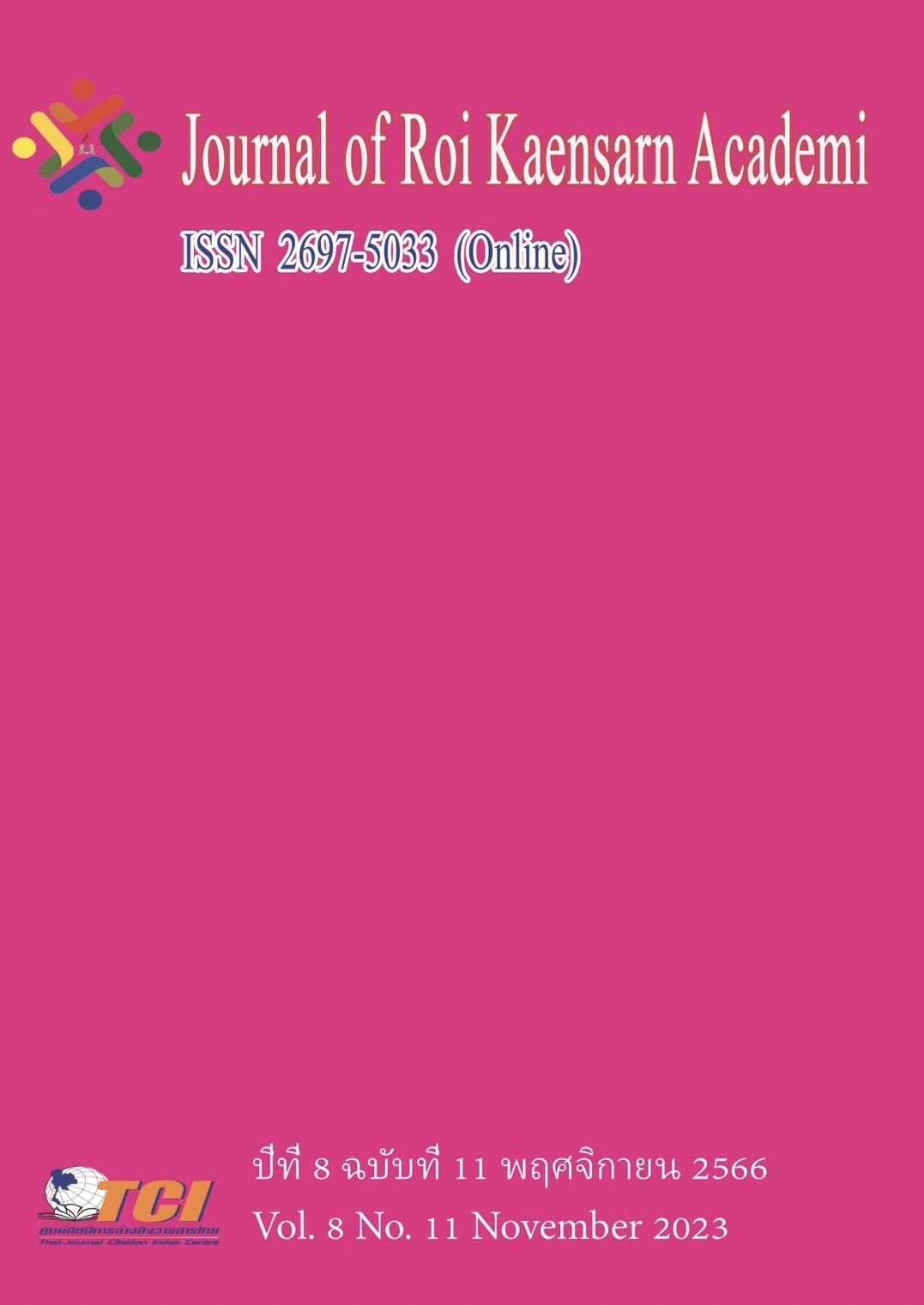โครงสร้างความสัมพันธ์เชิงสาเหตุพฤติกรรมทางการเงินของลูกค้าสินเชื่อพิโกไฟแนนซ์ในเขตกรุงเทพมหานครและปริมณฑล
Main Article Content
บทคัดย่อ
การวิจัยนี้มีวัตถุประสงค์เพื่อทดสอบและเปรียบเทียบโครงสร้างความสัมพันธ์เชิงสาเหตุพฤติกรรมทางการเงินของลูกค้าสินเชื่อพิโกไฟแนนซ์ในเขตกรุงเทพมหานครและปริมณฑล ระหว่างลูกค้าที่มีความน่าเชื่อถือทางเครดิตและลูกค้าที่ไม่มีความน่าเชื่อถือทางเครดิต กลุ่มตัวอย่างทั้งหมด 537 คน เป็นลูกค้าที่มีความน่าเชื่อถือทางเครดิต จำนวน 274 คน และลูกค้าที่ไม่มีความน่าเชื่อถือทางเครดิต จำนวน 263 คน จากการสุ่มตัวอย่างแบบหลายขั้นตอน เครื่องมือวัดตัวแปรมีจำนวน 9 ฉบับ มีความสอดคล้องของข้อคำถามกับวัตถุประสงค์ 0.50 ขึ้นไป และความเชื่อมั่นแต่ละตัวแปรอยู่ระหว่าง 0.84 ถึง 0.98 ผลการวิจัยที่สำคัญ มี 2 ประการ ดังนี้ ประการแรก โครงสร้างความสัมพันธ์เชิงสาเหตุพฤติกรรมทางการเงินของลูกค้าสินเชื่อพิโกไฟแนนซ์ในเขตกรุงเทพมหานครและปริมณฑลมีความกลมกลืนกับข้อมูลเชิงประจักษ์ มีค่าดัชนีวัดความสอดคล้อง = 315.29, df = 115, (p < 0.05), SRMR = 0.045, RMSEA = 0.057, GFI = 0.94, NFI = 0.92, CFI = 0.95, TLI = 0.93, AGFI = 0.91, PNFI = 0.69 และ /df = 2.74 โดยตัวแปรเชิงสาเหตุที่มีอิทธิพลรวมต่อพฤติกรรมทางการเงิน 3 อันดับแรก คือ เจตคติต่อพฤติกรรมทางการเงิน (ค่าอิทธิพลรวม 0.70) ทุนทางสังคม (ค่าอิทธิพลรวม 0.37) และความรอบรู้ทางการเงิน (ค่ารวมอิทธิพล 0.32) ตัวแปรเชิงสาเหตุทั้งหมดร่วมกันอธิบายความแปรปรวนของพฤติกรรมทางการเงินได้ ร้อยละ 85 ประการที่สอง กลุ่มลูกค้าที่มีความน่าเชื่อถือทางเครดิตมีความสามารถทางการเงินสูงกว่ากลุ่มลูกค้าที่ไม่มีความน่าเชื่อถือทางเครดิต โดยกลุ่มลูกค้าที่มีความน่าเชื่อถือทางเครดิตความรอบรู้ทางการเงินมีอิทธิพลต่อทักษะทางการเงิน (0.62) สูงกว่ากลุ่มลูกค้าที่ไม่มีความน่าเชื่อถือทางเครดิต (0.35)
Article Details
เอกสารอ้างอิง
สถาบันวิจัยพฤติกรรมศาสตร์ มหาวิทยาลัยศรีนครินทรวิโรฒ. (2559). พฤติกรรมศาสตร์มุมมองในศาสตร์ที่แตกต่าง. กรุงเทพมหานคร: ห้างหุ้นส่วนจำกัด โรจนพริ้นติ้ง (สำนักงานใหญ่).
ธนาคารแห่งประเทศไทย. (2563). รายงานผลการสำรวจทักษะทางการเงินของไทย ปี 2563. ธนาคารแห่งประเทศไทย.
ธนาคารแห่งประเทศไทย. (2564). “สินเชื่อส่วนบุคคลดิจิทัล” สินเชื่อยุคใหม่เพื่อคนตัวเล็ก. ธนาคารแห่งประเทศไทย.
Dlugosch, T. J., Klinger, B., Frese, M., & Klehe, U. C. (2018). Personality‐based selection of entrepreneurial borrowers to reduce credit risk: Two studies on prediction models in low‐and high‐stakes settings in developing countries. Journal of Organizational Behavior. 39 (5), 612-628.
Financial Services Authority. (2005). Measuring financial capability: an exploratory study. FSA Consumer Research 37.
Gyuroski, I. I. (2017). Predictors and Implications of Personal Finance Management. (PhD.). University of Chicago, Chicago, Illinois. (Psychology).
Hair, J. F., Black, W. C., Babin, B. J., Anderson, R. E., & Tatham, R. L. (1998). Multivariate data analysis (Vol. 5). 164-166.
Kahneman, D., & Tversky, A. (1979). Prospect Theory: An Analysis of Decision under Risk. Econometrica. 47 (2), 263-292.
Kahneman, D., & Tversky, A. (1984). Choices, values, and frames. American psychologist. 39 (4), 341.
Karlan, D. (2005). Using Experimental Economics to Measure Social Capital and Predict Financial Decisions. American Economic Review. 95 (5), 1688-1699.
Karlan, D. (2007). Social connections and group banking. Economic Journal. 117, F52–F84.
Karlan, D., Sendhil, M., & Omar, R. (2013). Measuring Personality Traits and Predicting Loan Default with Experiments and Surveys In Banking the World: Empirical Foundations of Financial Inclusion: MIT Press.
Klinger, B., Khwaja, A. I., & Del Carpio, C. (2013). Enterprising psychometrics and poverty reduction (Vol. 860). New York: NY: Springer.
Kunt, A. D., Klapper, L., Singer, D., & Oudheusden, P. V. (2015). The global findex database 2014: Measuring financial inclusion around the world. World Bank Policy Research Working Paper, 7255.
Lomax, R. G., & Schumacker, R. E. (2004). A beginner's guide to structural equation modeling: psychology press.
Perry, V. G. (2008). Giving credit where credit is due: The psychology of credit ratings. The Journal of Behavioral Finance. 9 (1), 15-21.
Perry, V. G., & Morris, M. D. (2005). Who is in control? The role of self‐perception, knowledge, and income in explaining consumer financial Behavior. Journal of Consumer Affairs. 39 (2), 299-313.
Shoji, M., Aoyagi, K., Kasahara, R., Sawada, Y., & Ueyama, M. (2012). Social capital formation and credit access: Evidence from Sri Lanka. World Development. 40 (12), 2522-2536.

